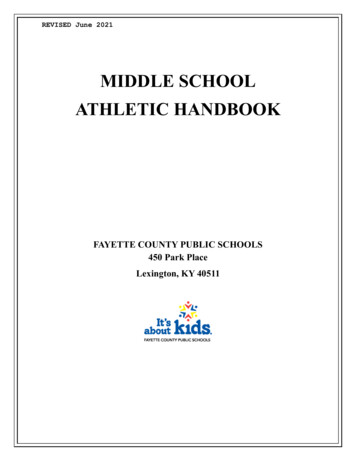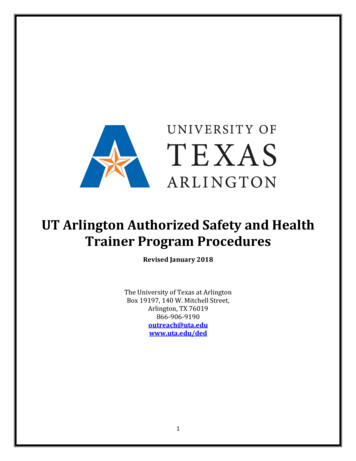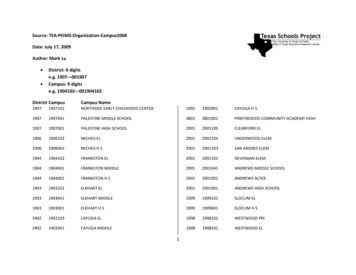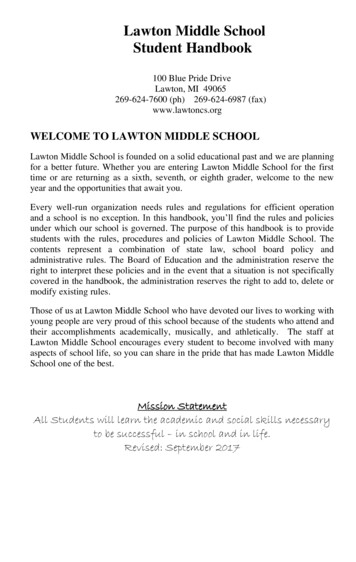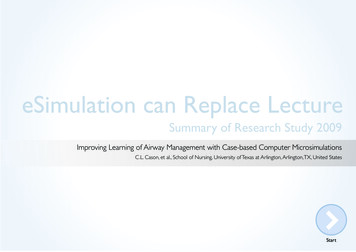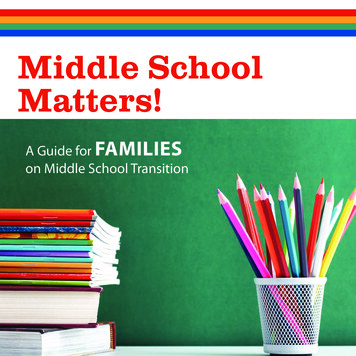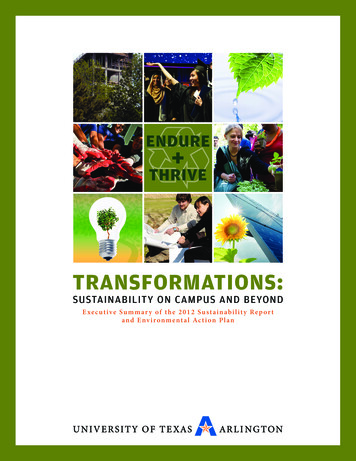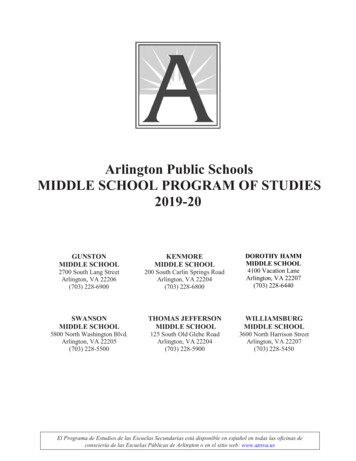
Transcription
Arlington Public SchoolsMIDDLE SCHOOL PROGRAM OF STUDIES2019-20GUNSTONMIDDLE SCHOOL2700 South Lang StreetArlington, VA 22206(703) 228-6900KENMOREMIDDLE SCHOOL200 South Carlin Springs RoadArlington, VA 22204(703) 228-6800DOROTHY HAMMMIDDLE SCHOOL4100 Vacation LaneArlington, VA 22207(703) 228-6440SWANSONMIDDLE SCHOOLTHOMAS JEFFERSONMIDDLE SCHOOLWILLIAMSBURGMIDDLE SCHOOL5800 North Washington Blvd.Arlington, VA 22205(703) 228-5500125 South Old Glebe RoadArlington, VA 22204(703) 228-59003600 North Harrison StreetArlington, VA 22207(703) 228-5450El Programa de Estudios de las Escuelas Secundarias está disponible en español en todas las oficinas deconsejería de las Escuelas Públicas de Arlington o en el sitio web: www.apsva.us
THE ARLINGTON MIDDLE SCHOOL PROGRAM OF STUDIESTABLE OF CONTENTSMessage from Tara Nattrass, Assistant Superintendent of Teaching and Learning. 3Preface . 5Statement of Purpose. 5Intellectual Growth. 5The Core Curriculum . 5The Exploratory/Electives Program . 6Act II . 6Differentiation Guidelines . 6Aspire2Excellence. 6Preparation for Rigorous Courses . 7Prerequisite Exceptions . 7Instructional Areas of Study. 8Grade 6 . 9Grade 7 . 16Grade 8 . 25Supplemental Courses/ProgramsGunston Middle School. 37Spanish Immersion Program and Middle School Montessori ProgramJefferson Middle School. 39International Baccalaureate Middle Years ProgrammeKenmore Middle School . 42Arts and Communication Technology Focus ProgramSwanson Middle School . 46Special PopulationsStudents Who Receive Special Education Services . 48Students Who Receive ESOL/HILT Services . 48Students Who Receive Gifted Services . 49Library Services . 49Extracurricular Athletic Program . 49Social Emotional Growth . 50Teacher Advisory Program . 50Student Services & Special Education . 50Homebound Instruction . 51Student Activities . 51Home/School Cooperation and Communication. 51Standardized Testing in the Middle School . 52Courses for High School Credit at the Middle School . 52Options for High School . 52Suggested Mathematics Course Pathways . 54World Languages Sequences of Study . 56High School Graduation Requirements. 581
2
January 2019Dear Arlington Families:Welcome to the middle school program of the Arlington Public Schools! We hope you will use this documentas a reference and a guide as you plan your middle school sequence of courses. The Program of Studiesprovides students and parents both general and specific information about curricular offerings and services atthe middle schools. In our efforts to achieve clarity and conciseness, we have written brief, objectivedescriptions of the many elements of the middle schools. You can obtain more information on most of thetopics by calling your middle school counseling services office:Gunston Middle SchoolJefferson Middle SchoolKenmore Middle SchoolSwanson Middle SchoolDorothy Hamm Middle SchoolWilliamsburg Middle School703/ 228 - 6909703/ 228 - 5908703/ 228 - 6798703/ 228 - 5508703/ 228 - 6440703/ 228 - 5445Students have many choices as they pursue their interests and expand their experiences. The student, theparents, and the counselor should work together to plan the three years of middle school and to makeappropriate revisions along the way. The student’s long-range goals and interests as well as the requirements forgraduation should guide the decision-making. The 2019-20 Program of Studies supports the process of planningand looking toward the future. Additionally, with the Offices of Counseling Services will reveal many othersupports. For example, the schools provide small-group homework assistance on teams for students seekingextra help with organization or content.Several of the middle schools also offer focus programs that reflect the unique directions that middle schoolshave taken in meeting the specific needs of their students. All of the other courses are offered at all five middleschools.We encourage you to maintain communication with your school through orientations, Back-to-School Night,and other scheduled opportunities. You may also call and schedule an individual appointment.We hope you take advantage of the many opportunities available to you during your years in middle school.Sincerely,Tara NattrassAssistant Superintendent, Department of Teaching & Learning3
4
MIDDLE SCHOOL PROGRAM OF STUDIESPREFACEEach individual Arlington middle school is organized to promote the intellectual, physical, social, and emotional growthof each child. The Program of Studies describes the academic programs, services, and activities the middle schools offerin each of these areas for students in Grades 6, 7, and 8.In addition to local standards, the Virginia State Board of Education and the Southern Association of Colleges andSchools establish accreditation standards designed to provide a foundation for quality education. Accreditation standardsgive schools guidance and direction in their continuing efforts to offer educational programs to meet the needs, interests,and aspirations of all students. The accreditation standards are designed to achieve the following objectives:1. Seek to ensure that schools provide educational programs of high quality for all students2. Encourage continuous appraisal and improvement of the school program3. Foster public confidence4. Assure recognition by other institutions of learningSTATEMENT OF PURPOSEArlington Middle Schools will ensure a child-centered approach to continuous learning, social development, emotionalgrowth, and physical well-being of young adolescents from ten to fourteen years of age. The middle school, with theactive support of teachers, staff, parents, community, and students, will provide an atmosphere of acceptance,understanding, and respect for a diverse population.Arlington Middle Schools, Grades 6-8, will provide early adolescents with an environment in which to learn and growduring the transitional years between elementary and high school. The intellectual, social, emotional, and physical growthof middle school children will be the focus of curriculum and staff development. Interdisciplinary teacher teaming,flexible block scheduling, teacher advisor programs, exploratory options, and an extensive after-school activity programwill be integral parts of the middle schools. Through effective and comprehensive academic learning in a caringenvironment, students will have the opportunity to become thoughtful, productive, and contributing members of society.INTELLECTUAL GROWTHA primary task of education is to foster intellectual growth through the learning activities which staff members design anddirect for students. In the middle school, students in Grades 6, 7, and 8 pursue a core curriculum of academic subjects(English, mathematics, science, and social studies, with reading at Grade 6) during a prescribed block of time and thenstudy, exploratory/electives, and non-core subjects during the rest of the day.THE CORE CURRICULUMStudents are assigned in groups to teams for their core subjects. This means that approximately fifty to one hundred andtwenty-five students of a single grade level are assigned to a single team of two to five teachers who teach the coresubjects. These teachers cooperate by meeting during a team planning period when they discuss students’ instructionalneeds, plan upcoming activities, divide the core block of time according to subject needs, and integrate the curricularareas. Teacher teams integrate subjects when appropriate by designing learning experiences which emphasize theinterdependence of curricula, perhaps through projects, common skill instruction, related concepts, or thematic units.Teams also infuse career education activities into the core curriculum. Although students are assigned to specific teams,teachers within the team regroup students as appropriate for particular instructional activities. Teachers make suchregrouping decisions during team meetings, basing their decisions on the needs and progress of individual students.Students who need remediation in particular skill areas receive remediation during the core period of time or throughother courses and/or programs.5
THE EXPLORATORY/ELECTIVES PROGRAMThe middle school provides a variety of learning experiences through the exploratory/electives courses. Through thesecourses, students have opportunities to develop new interests and discover new abilities with the specialized staff andfacilities of the middle school. Elective course offerings depend on sufficient student enrollment. Exploratory and electiveclasses vary in their meeting schedules and in the amount of curriculum they cover.ACT IIAct II provides students an opportunity to take additional elective courses after school. Classes offered through Act II areelectives in the Program of Studies and vary at each school based on student interest and scheduling. Classes are taught onan alternative schedule (i.e., 2 days per week but for a longer class time or with other variations) with the same rigor asclasses held earlier in the day. Attendance is mandatory and grades are earned. Transportation is provided using theexisting late bus schedule.Look for opportunities to indicate interest in Act II classes during the course scheduling process or check with your gradelevel counselor concerning the Act II opportunities offered at your school each semester.DIFFERENTIATION GUIDELINESDifferentiation is the process of teaching and learning that begins with the premise that not all children learn in the sameways. It is based on Readiness (a student’s prior mastery of knowledge, understanding, and skill) Interest (a student’s curiosity and passion that “hooks” the learner into wanting to know more) Learning profile (how a student prefers to learn)When differentiating instruction, teachers plan and carry out various instructional approaches that Assess student’s readiness, interest, and/or learning profile Scaffold student learning in order to support student’s success at complex tasks Modify content (what a student learns), process (activities by which a student learns), or product(demonstration of what a student learns)Students of varying achievement levels are assigned to teacher advisor, health and physical education, elective, andexploratory courses. Students of varying achievement levels are assigned to teams for instruction in the core academicsubjects. Teachers accommodate their instructional needs through differentiation, which may include the use of flexibleinstructional groups.Teachers base flexible group decisions on skill levels as determined by various instructional approaches, achievementtests such as the previous Standards of Learning assessments, subject-specific diagnostic tests, student performance incurrent and past classes, and teacher knowledge of special characteristics of students.ASPIRE2EXCELLENCEAspire2Excellence is the academic planning initiative designed to provide families with information as they are planningfor their child’s future in APS. Aspire2Excellence underscores the importance of every student taking rigorous coursesand meeting rigorous graduation requirements in order to ensure college and career readiness after high school. For moreinformation, contact your child’s school counselor and/or go to https://www.apsva.us/academic-planning/6
PREPARATION FOR RIGOROUS COURSESArlington Public Schools encourages all students to enroll and succeed in advanced courses. Successful participation inadvanced courses instills in students a sense of accomplishment, increased self-esteem, improved study skills, and agreater foundation for success in subsequent advanced courses and for life beyond school. It is not however, enough forstudents to simply desire to enroll in advanced courses. A solid foundation of knowledge and skills is necessary andserves as a good predictor of success in advanced courses.Therefore, it is important that students strive to do their very best in all courses in order to build a solid foundation foracademic success. This includes developing effective study habits, completing assignments, meeting deadlines, asking forhelp or putting in extra time when it is needed, and being successful in fundamental courses that serve as the foundationfor advanced courses. Doing one’s best also includes doing more than the minimal requirements for classes by completingprojects or other enriching or skill building activities. Students and parents are encouraged to work closely with teachersand counselors to build, support, and promote these skills in order to maximize opportunities for enrolling in and beingsuccessful in advanced courses. All Grade 6 students in consultation with counselors and parents are required to completea Six-Year Academic Plan and to update and refine that plan as they progress through each middle school grade. ByGrade 9, the six-year plan has been replaced with a four-year plan, which is also updated and refined each year asstudents’ progress through high school.Advanced courses may be defined by when a student takes a course as well as by enriched or accelerated content, andmight be labeled “advanced” or “intensified.” For example, Geometry in Grade 8 would be considered an advancedcourse whereas Geometry in Grade 10 would not. In middle school, advanced courses are considered those courses thatallow selected students to earn high school credits in middle school such as in World Language, Algebra I, or Geometry(Geography, taken for high school credit by all Grade 8 students, is not considered an advanced course). These coursesalso serve as gateways for courses in high school. The table below presents two examples of how rigorous courseselections in middle school might impact students’ later high school course options and opportunities.Course:Algebra IImplication:The sequence of mathematics courses is Algebra I, Geometry, and Algebra II. A student interestedin rigorous science courses in high school would take Intensified Chemistry in Grade 10.(Advanced Placement courses allow students to earn college credits while in high school.) AlgebraII is a co-requisite for Intensified Chemistry. Also, because Algebra I is a high school course,successful completion of Algebra I by Grade 8 enables a student to earn credits toward graduationearly.Spanish I and IITaking Spanish II in Grade 9 enables a student to take Spanish III, IV, and even V in Grades 10, 11,and/or 12 or to take at least two years of another language in high school. Note that for an advancedstudies diploma, a diploma more favorable for college admission, three years of one or two yearseach of two different foreign languages is required.PREREQUISITE EXCEPTIONSBeginning in middle school, students have the opportunity to enroll in advanced courses that may have suggested courseprerequisites. The prerequisites are listed to help communicate to students and families what skills or experience may beneeded to ensure a student’s success in a course. Parents may still enroll their students in these courses without havingcompleted prerequisites, but following this guidance is highly recommended. Parents should discuss their preferenceswith members of the school staff, especially with their child's counselor. The purpose of soliciting this feedback is toincrease the likelihood of student success and inform parents of the academic rigor and requirements of these courses. If aparent decides to enroll a student in a course that was not initially recommended for the student, the parent should notifythe school staff of this decision before the end of the school year or as soon as possible after the parent receives notice ofthe placement.7
INSTRUCTIONAL AREAS OF STUDYThe following pages outline major skills and content which students are expected to learn at each of the middle schoolgrade levels while enrolled in specific courses. This display is not to be considered a complete listing of what studentsare taught and expected to achieve. Parents who desire to review the full range of grade level objectives or programdescriptions are encouraged to review local and state curriculum guides and text materials available in each school and/orcontact the supervisor of the instructional area.ARTS EDUCATION, Pam Farrell, Supervisor . 703-228-6169BUSINESS & INFORMATION TECHNOLOGY, COMPUTER SCIENCE & MARKETING, TECHNOLOGYEDUCATION & FAMILY & CONSUMER SCIENCES, Phyllis Gandy, Supervisor . 703-228-7213CAREER, TECHNICAL, & ADULT EDUCATION, Kris Martini, Director . 703-228-7207CURRICULUM & INSTRUCTION, Sarah Putnam, Director . 703-228-2879ENGLISH LANGUAGE ARTS, Lori Silver, Supervisor. 703-228-8045ESOL /HILT, Sam Klein, Supervisor . 703-228-6091GIFTED SERVICES, Cheryl McCullough, Supervisor . 703-228-6160HEALTH & PHYSICAL EDUCATION, Deborah DeFranco, Supervisor . 703-228-6165MATHEMATICS, Shannan Ellis, Supervisor . 703-228-6135SCIENCE, Dat Le, Supervisor. 703-228-6166SOCIAL STUDIES, Kerri Hirsch, Supervisor . 703-228-6140SECONDARY EDUCATION, Tyrone Byrd, Director . 703-228-7222SPECIAL EDUCATION, Paul Jamelske, Director . 703-228-6049WORLD LANGUAGES, Elisabeth Harrington, Supervisor . 703-228-60978
HEALTH AND PHYSICAL EDUCATIONGrade 6 Health and Physical Education (17110)All Grade 6 students participate in the health andphysical education program.The health education program emphasizes what studentsneed to know, understand and do to achieve a healthylifestyle. Instruction will address adolescent healthissues, decision-making skills and consequences.Students will understand peer pressure, respectingindividual differences and opinions. Students will learneffective face-to-face and online communication skills.Areas of study include emotional, mental, social ess, relationships, substance abuse and diseaseprevention, and family life education. The physicaleducation program will apply knowledge of anatomicalstructures to movement principles to improveperformance. Students will demonstrate confidence andcompetence in movement skills along with cooperativeand small-group activities in a variety of physicalactivity settings. Students will explain the connectionbetween energy balance, nutrition and wellness.GRADE 6 CORE CURRICULUMGrade 6 students study the following subjects during thecore block of time. Within each subject area studentsreceive remediation and enrichment as appropriate. (Seepage 6 for differentiation information.)ENGLISH LANGUAGE ARTSGrade 6 English (11109)In all middle schools, the English Language ArtsProgram focuses on five organizing evelopment, writing, and research. Competence in theseareas leads to advanced student thinking in all subjectsand success in and out of school.Students will Participate in small group activities Listen critically and express opinions in oralpresentations Understand the elements of media literacy Read and learn the meanings of unfamiliar words Read a variety of fiction and narrative nonfiction Learn a variety of reading strategies to understandtext Read and write a variety of poetry Write narratives, descriptions, exposition, andpersuasion Use reading and writing as tools for learning in allsubjects Revise and edit writing Find, evaluate, and select appropriate resources for aresearch productMATHEMATICSMath 6 (13110)Math 6 is a core course that provides a rigoroustreatment of content for sixth grade students.The Grade 6 standards are a transition from the emphasisplaced on whole number arithmetic in the elementarygrades to foundations of algebra.Students will build understanding within these strands:1. Number and Number Sense2. Computation and Estimation3. Measurement and Geometry4. Probability and Statistics5. Patterns, Functions, and AlgebraGrade 6 ReadingFull Year (11106)Semester (11108) (not offered a Thomas JeffersonMiddle School)The sixth grade Reading course is recommended for allstudents to provide a standards-based framework thathelps students transition from learning to read inelementary school to reading to learn in middle school.This course focuses on the Reading and Communicationstrands of the Virginia Standards of Learning. Thepurposes of sixth grade reading are to build a passion forlifelong reading, explore full length texts in differentgenres (including fiction and non-fiction), use readingstrategies while analyzing text, explore and buildvocabulary, develop note taking skills, and learn tocommunicate and collaborate in diverse teams.Note that the Semester option is for students who elect toenroll in Intro to World Languages. Students selectingthe Semester option paired with Intro to WorldLanguages should have strong scores on previousreading achievement tests. Consult with your teacherand counselor about whether the Semester option isrecommended.In addition, the content of the standards is intended tosupport the following process goals for learningmathematics: Problem Solving, Communications,Connections, Representations, and Reasoning.More specific examples of content components of theMathematics Virginia Standards of Learning (SOL) forGrade 6 include: Operationswithfractions,decimals,andpercentages, including representational models andpractical problems. Multistep practical problems involving fractions,mixed numbers, and decimals. Integer operations, including integer model andorder of operations. Discovering and exploring pi, circles, and circlegraphs.9
Measures of central tendency, including mean asbalance criptions, rates, ratio tables, and graphs.Equations and inequalities. Pre-Algebra for 6th Graders (6/7/8)Full Year (13128)Pre-Algebra for 6th Graders (6/7/8) is a rigoroustreatment of all middle school math content found in theVirginia Standards of Learning for Grade 6, Grade 7,and Grade 8. This intensified course includes all prealgebra content that students need to master prior tostudying Algebra I, Intensified and Geometry,Intensified. Students will build understanding within each prealgebra strand:1. Number and Number Sense2. Computation and Estimation3. Measurement and Geometry4. Probability and Statistics5. Patterns, Functions, and Algebra In addition, the content of the standards is intended tosupport the following process goals for learningmathematics: Problem Solving, Communications,Connections, Representations, and Reasoning. More specific examples of the content of this courseincludes: Operationswithfractions,decimals,andpercentages, including representational models andpractical problems. Multistep practical problems involving fractions,mixed numbers, and decimals. Integer operations, including integer models andorder of operations. Discovering and exploring pi, circles, and circlegraphs. Measures of central tendency, including mean asbalance point. ons, rates, ration tables, and graphs. The real number system including computing andclassifying with subsets of the system. Positive and negative exponents, including the orderof operations. Solving multiple practical problems involvingrational numbers, proportional reasoning andsimilarity. Slope as rate of change. Proportional relationships and additive relationshipsrelated to graphing a line and other practicalproblems. Practical problems involving consumer applicationsQuadrilaterals.Determine the measure of unknown angles based onangle relationships.Solving practical problems involving volume andsurface area of a wide range of figures, includinganalysis and description of the effects of changingattributes.Apply transformations including translations,reflections, and dilatations.Constructed three-dimensional models given variousviews.Apply and verify the Pythagorean Theorem.Solve practical area and perimeter problemsinvolving composite figures.Compare and contrast the probability of independentand dependent events and compute probabilities.Represent, make observations and inferences from,and compare and analyze data using a wide varietyof graphs including boxplots, scatterplots, andhistograms.Evaluate and simplify algebraic expressions.Domain, range, dependent, and independentvariables.Identify and interpret slope and intercept a functiongiven values, a graph, or an equation and makeconnections among verbal descriptions, tables,equations, and graphs.Sol
GUNSTON MIDDLE SCHOOL : 2700 South Lang Street : Arlington, VA 22206 (703) 228-6900 . KENMORE MIDDLE SCHOOL : 200 South Carlin Springs Road : Arlington, VA 22204 . during the transitional years between elementary and high school. The intellectual, social, emotional, and physical growth


